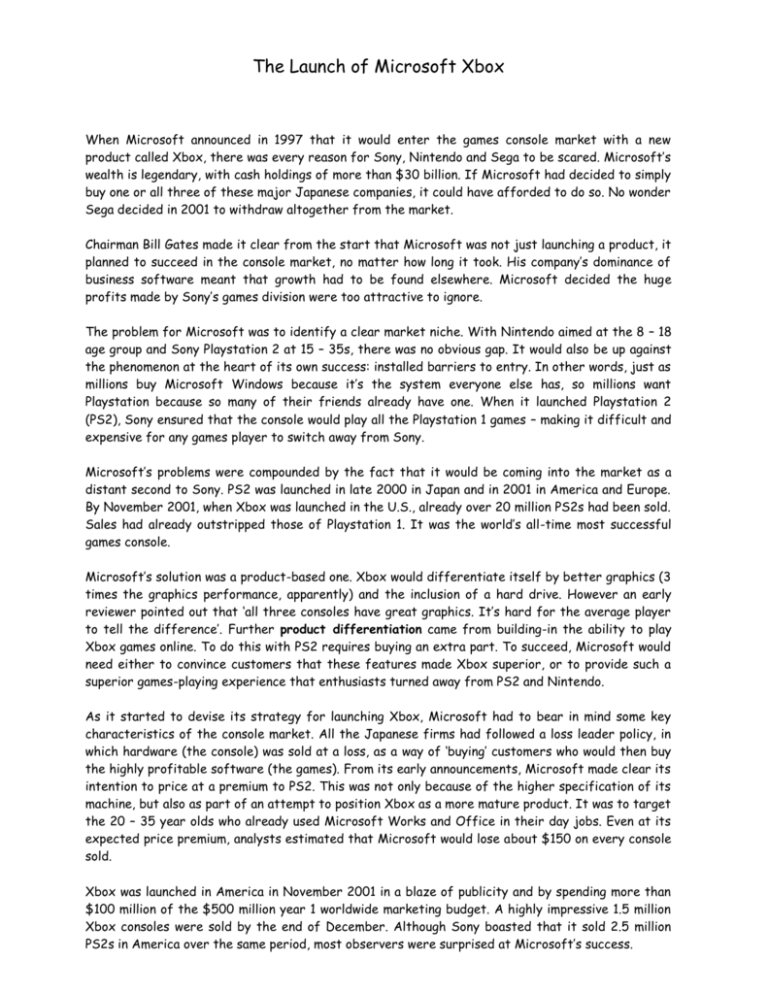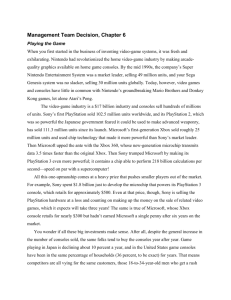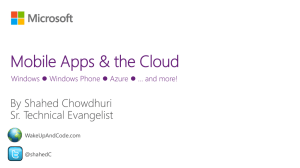The Launch of Microsoft Xbox - Devonport High School for Girls
advertisement

The Launch of Microsoft Xbox When Microsoft announced in 1997 that it would enter the games console market with a new product called Xbox, there was every reason for Sony, Nintendo and Sega to be scared. Microsoft’s wealth is legendary, with cash holdings of more than $30 billion. If Microsoft had decided to simply buy one or all three of these major Japanese companies, it could have afforded to do so. No wonder Sega decided in 2001 to withdraw altogether from the market. Chairman Bill Gates made it clear from the start that Microsoft was not just launching a product, it planned to succeed in the console market, no matter how long it took. His company’s dominance of business software meant that growth had to be found elsewhere. Microsoft decided the huge profits made by Sony’s games division were too attractive to ignore. The problem for Microsoft was to identify a clear market niche. With Nintendo aimed at the 8 – 18 age group and Sony Playstation 2 at 15 – 35s, there was no obvious gap. It would also be up against the phenomenon at the heart of its own success: installed barriers to entry. In other words, just as millions buy Microsoft Windows because it’s the system everyone else has, so millions want Playstation because so many of their friends already have one. When it launched Playstation 2 (PS2), Sony ensured that the console would play all the Playstation 1 games – making it difficult and expensive for any games player to switch away from Sony. Microsoft’s problems were compounded by the fact that it would be coming into the market as a distant second to Sony. PS2 was launched in late 2000 in Japan and in 2001 in America and Europe. By November 2001, when Xbox was launched in the U.S., already over 20 million PS2s had been sold. Sales had already outstripped those of Playstation 1. It was the world’s all-time most successful games console. Microsoft’s solution was a product-based one. Xbox would differentiate itself by better graphics (3 times the graphics performance, apparently) and the inclusion of a hard drive. However an early reviewer pointed out that ‘all three consoles have great graphics. It’s hard for the average player to tell the difference’. Further product differentiation came from building-in the ability to play Xbox games online. To do this with PS2 requires buying an extra part. To succeed, Microsoft would need either to convince customers that these features made Xbox superior, or to provide such a superior games-playing experience that enthusiasts turned away from PS2 and Nintendo. As it started to devise its strategy for launching Xbox, Microsoft had to bear in mind some key characteristics of the console market. All the Japanese firms had followed a loss leader policy, in which hardware (the console) was sold at a loss, as a way of ‘buying’ customers who would then buy the highly profitable software (the games). From its early announcements, Microsoft made clear its intention to price at a premium to PS2. This was not only because of the higher specification of its machine, but also as part of an attempt to position Xbox as a more mature product. It was to target the 20 – 35 year olds who already used Microsoft Works and Office in their day jobs. Even at its expected price premium, analysts estimated that Microsoft would lose about $150 on every console sold. Xbox was launched in America in November 2001 in a blaze of publicity and by spending more than $100 million of the $500 million year 1 worldwide marketing budget. A highly impressive 1.5 million Xbox consoles were sold by the end of December. Although Sony boasted that it sold 2.5 million PS2s in America over the same period, most observers were surprised at Microsoft’s success. At the time of the launch, Sony’s president said that ‘The biggest threat to Playstation is that Xbox changes the industry’s life cycle’. Traditionally consoles have had five year product life cycles, allowing manufacturers to recoup initial losses on hardware by generating substantial profits through software sales (see the 5-year graph of Sony’s games division). If Xbox succeeded, Sony would have to bring in Playstation 3 earlier, therefore robbing it of the main years of profit, and condemning software companies to sharply reduced profits. Index: 1998 = 100 Graph to show Sony Playstation sales and profit cycle 160 140 120 100 80 60 40 20 0 -20 -40 -60 Sales Profits 1998 1999 2000 2001 2002 Source: Sony Corporation Annual Accounts 2002 In February 2002 it was time for the Japanese launch, but this proved a disaster. Few were impressed in advance, given that Xbox had only 20 compatible games compared with 200 for PS2. Then, a week after the launch, came press stories of faulty Xbox consoles that scratched the CD games. Embarrassing though the stories were, Microsoft had never held out much hope for Japan, the fortress of Sony and Nintendo. Far more important was the European launch in March 2002. Microsoft announced a sales target of 4.5 – 6 million consoles by the end of June. This could only be achieved by success in Europe, especially Britain and Germany. In Britain, the marketing of Xbox had begun with a multi-million pound public relations (PR) campaign begun in January 2001. Its objectives were to promote Xbox as the world’s most advanced video-games console and to position it as ‘the console worth waiting for’. In May 2001 European journalists were flown out to America to play Xbox for the first time. This was to get favourable coverage from games magazines and other specialist journalists. Later in the summer special showcase events were organised for games enthusiasts at Cannes, than in London, Birmingham, Manchester and Glasgow. Then, in March 2002, the launch was given the hype of special midnight openings of Virgin Megastores, with Richard Branson personally selling the first Xbox in Britain. Worryingly, though, few buyers turned up at midnight, leading to caustic press comment. When evaluating the success of its PR campaign, Microsoft noted that 500 journalists attended the Cannes event and that TV and press media coverage gave 478 million opportunities to see or hear about Xbox. Yet research showed only 14% ‘prompted awareness’ of Xbox in December 2001, which had doubled by June 2002, but only to 28%. The PR campaign was supplemented by a large-scale TV advertising campaign that began in May 2002. Microsoft hired the top London advertising agency responsible for Levi’s and Barclays Bank campaigns. The commercial featured a baby shot from a window, visibly ageing as he hurtled through the air until crashing into a grave as an old man. The tag-line was ‘Life is short. Play more’. Astonishingly, Microsoft was forced to withdraw this TV advertisement on June 6 th as a result of 136 complaints to the Independent Television Commission. The complaints included 20 from bereaved families and one from a mother whose baby had died. This PR disaster was not helped by the insistence of Neil Thompson, Xbox European marketing director, that “We set out to create powerful, impactful advertising and this decision is not going to affect that strategy at all”. Despite being forced to withdraw the commercial from TV screens, Microsoft continued to show it in cinemas. A further arm of Microsoft’s marketing strategy had been to set up a major European website called Playmore.com. This was featured in all the above-the-line promotion. Yet in June Microsoft overhauled the website as it had ‘failed to ignite the interest of games enthusiasts’. With its promotional strategy in tatters, sales were proving very sluggish. In response, Microsoft felt compelled to cut its console price throughout Europe. This was a humiliation, as it made it clear that the product could not command a price premium over Playstation. More of a surprise was Microsoft’s decision to cut the U.S. price of Xbox from $299 to $199 in late April. This led to some favourable publicity in July, when the company was able to boast that U.S. sales had doubled in May and June compared with March and April. UK Games console prices – announced and actual 2002 Xbox PS2 GameCube FEB 2002 £299 £249 £199 MARCH 2002 £299 £249 £169 APRIL 2002 £199 £199 £139 SEPT 2002 £152.99 £159.99 £127.99 The reason behind the U.S. price cut was probably the wish to meet or beat the earlier sales forecast of at least 4.5 million units worldwide by the end of June. In fact, even with the price cutting, sales only reached 3.9 million. Contrast this with Sony’s cumulative sales on PS2 of 33 million by June 2002. (And remember that, assuming an average selling price of just £100, that still represents a sales value of £3,300 million, just for the hardware.) Even before the end of June, Kazuo Hirai, the head of Sony Computer Entertainment announced ‘the console war is over’. He pointed to the sales figures demonstrating Sony’s remarkable success and forecast that PS2 sales would exceed 50 million by March 2003. Sony’s 2002 accounts showed that Playstation generated 60% of the whole company’s profits worldwide. Almost certainly the next accounts will show PS2 to have been even more important in 2002/2003. Microsoft response to Hirai’s announcement was very considered. It did not argue with Sony’s assessment of PS2 v Xbox 1. But it announced spending of $2 billion on Research & Development for Xbox to make sure that whenever Playstation 3 arrives, Xbox 2 will be waiting. Xbox has lost round one, but with cash cows such as Windows, Word and Office, it will not be giving up on its problem child. Sources: Financial Times, Marketing Week, PR Week, Sony Corporation annual report Questions (50 marks; 90 minutes) 1. Explain the meaning of the following terms: a) product differentiation b) above-the-line c) problem child (9 marks) 2. Examine two ways in which Microsoft might have been helped by a careful programme of market research in Britain. (8 marks) 3. Explain the business significance of: a) installed barriers to entry b) changing ‘the industry’s life cycle’ (5 marks) (5 marks) 4. Based upon analysts’ estimates of the cost to Microsoft of every Xbox sold, calculate how much Microsoft had lost on this product launch by the end of June 2002. (3 marks) 5. Discuss the appropriateness of the pricing strategy adopted by Microsoft. (10 marks) 6. To what extent do you agree with Kazuo Hirai’s statement that ‘the console war is over’? (10 marks)






